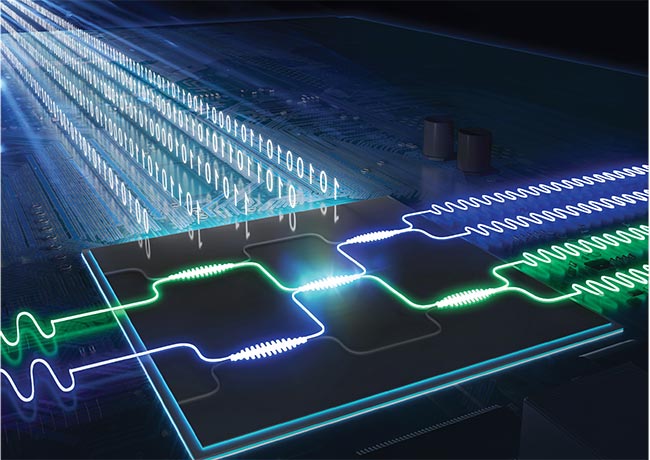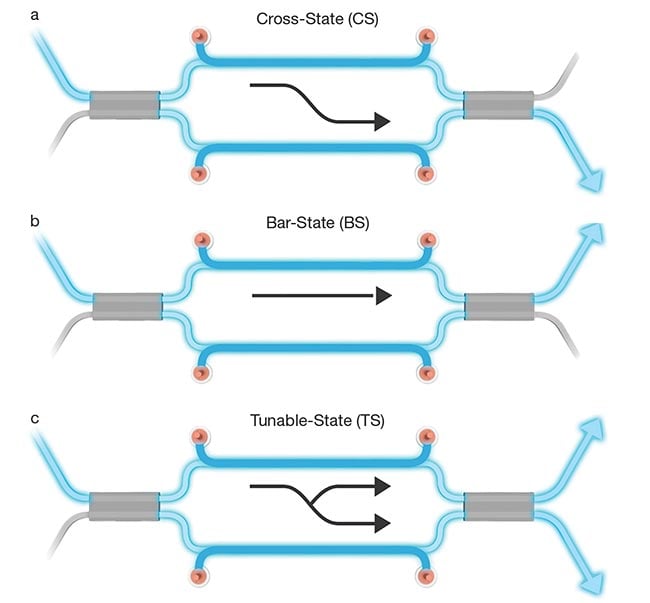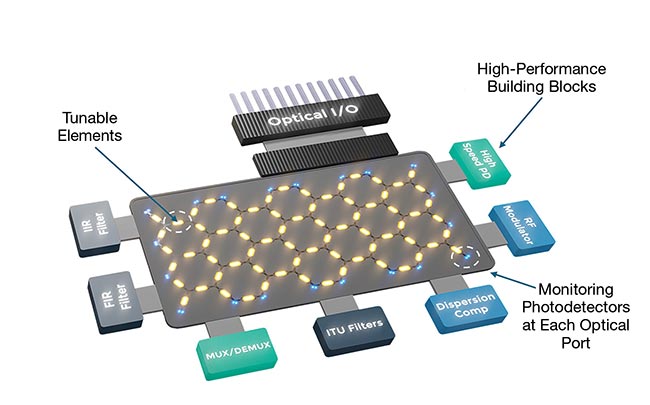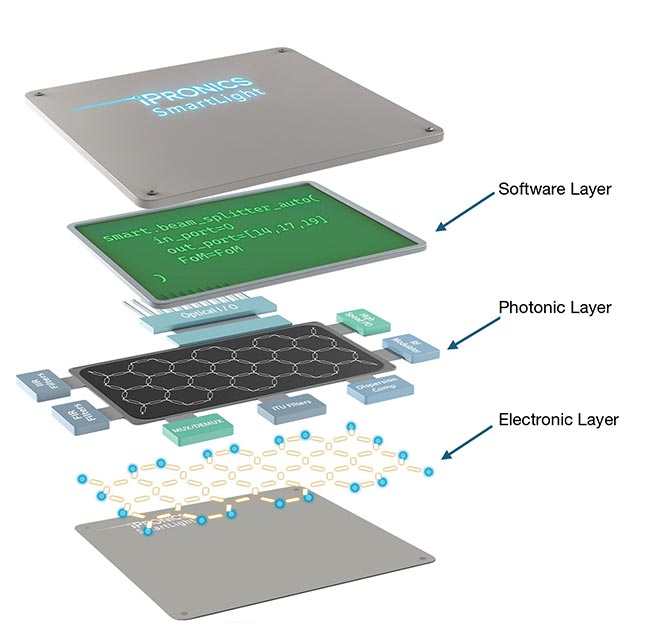The demand on data centers necessitates constant innovation in network optimization. Hardware that combines photonics, electronics, and a software layer holds transformational potential rooted in programmability.
ANA GONZÁLEZ, IPRONICS PROGRAMMABLE PHOTONICS
At a system architecture level, software-defined networking (SDN) has transformed data center management in the last decade, decoupling the control plane element from the data plane element. The flexibility in this design
innovation enables dynamic traffic routing, network adjustments, and resource allocation — all through software control.
Already, this highly coveted advancement has demonstrated massive benefits for network communications. Yet, the full potential of SDN’s orchestration capabilities for the data center remains limited, due largely to the rigidity of the physical
hardware needed to support such an application. In addition, many existing network devices, particularly in telecom settings, lack open application programming interfaces (APIs). This renders them incompatible with SDN controllers.

A convergence of software and photonics is charting a course for dynamic traffic optimization as changing network conditions and user demands soar toward new volumes. Courtesy of iPronics Programmable Photonics.
It is easy to comprehend certain aspects of this bottleneck. The development of hardware takes on more risk and requires more investment than the development of software. And, in certain subfields of communications, software and hardware often progress at different rates.
To avoid these discrepancies, network disaggregation promotes open hardware designs (with a push toward standardization). Developing programmable interfaces and open-source hardware designs where infrastructure components are conceptualized and then modeled as “white-box” switches achieves this industry requirement.
Technology must bridge the gap between SDN and the hardware layer. The ideal hardware to achieve this goal must function as an intelligent element, dynamically adjusting functionalities based on instructions delivered by the software. Imagine fiber paths reconfiguring for real-time traffic changes; bandwidth dynamically allocated to prioritize critical applications; and network topologies adapting on the fly — all through software control.
With increasing bandwidth requirements driving the present and future of datacom and telecom, photonic technologies are well-positioned candidates to replace electronic technologies when
electronics reaches its limit for a particular application. If these photonics platforms are to be the optimal solution(s) to perform within the software environment of these fields, these systems will possess the qualities of programmability, adaptability, and flexibility.
As questions over the future viability of Moore’s law persist, recent advancements in photonic integration have yielded programmable PICs, opening the door to a scenario in dynamic traffic optimization based on changing network conditions and user demands1-3. From this convergence of software and photonics, software-defined photonics (SDP) is poised to enable advancements that offer direct benefits to data centers.
Core advantages
To weigh the advantages of the use of SDP, enhancements to overall system performance and, more crucially, to the application areas that benefit from such improvements must be considered. Static hardware — meticulously designed into fixed configurations for specific tasks — has backboned unprecedented progress in optical communications. This hardware supports an approach that excels in stability and performance.
However, the direction and advent of technologies in telecom and datacom makes it clear that this hardware approach lacks the adaptability needed to support sustained progress to the ever-evolving communications landscape.
Adaptivity is an immediate benefit to SDP. Under the umbrella of real-time operability capabilities, SDP technologies adapt to fluctuations, such as signal changes, in a matter of nanoseconds.
To deliver maximum productivity for the end user, they also provide real-time insights and data-driven decision-making capabilities. This optimizes resource
allocation.
The parallelization of tasks further
bolsters resource allocation. With
multiple photonic functions conducted on the same device, execution times increase while the mechanism eliminates the need for optical/electrical/optical (OEO) conversions. This fundamentally cuts latency and improves efficiency. Also, it ensures that fewer systems are needed to perform complex tasks, which is a critical advantage in resource-limited settings.
As much as adaptability pertains to pre- and in-function optimization, the possibilities that SDP presents also envelop reconfiguration and recovery. Today, advanced SDP technologies are envisioned to incorporate self-healing capabilities, and to be optimized for a given function. This quality aims to allow these technologies to detect and respond to faults in a given system. The automatic diagnosis of system issues, reconfiguration capabilities, and recovery from failures minimizes downtime and enhances system availability.
Finally, SDP technologies currently under design are to be transparent
to bandwidth and enable different
approaches to data management and processing. Clear benefits are point-to-point and multipoint switching and add-drop-wavelengths, as well as the possibility to support on-the-fly correction of impairments by filtering or applying delays without the need for OEO conversions and memories that add latency, which may represent a significant percentage of the power consumption in a network. Wavelength division multiplexing is another supported capability. Since SDN enables users to manage complex and dynamic traffic patterns efficiently, situations may occur in which existing network capacity using the traditional single-wavelength transmission becomes insufficient. SDP technology will help overcome this bottleneck, which will be critical to move bandwidth-hungry applications, such as cloud computing and artificial intelligence, toward the mainstream.
Programming takes shape
Before integrators can reap the benefits
of increasingly flexible replacement
hardware solutions, designers and engineers must address the considerable hurdles to integration. Some challenges — relating to straightforward design geometries and the selection of
components — are fundamental, and immediately apparent. Others are more technically daunting. As mentioned,
integrating flexible hardware with existing, static infrastructures can pose problems in compatibility.
A concept for programming a tunable element relies on phase actuators (Figure 1a-c). The element consists of two-input ports and two-output ports, where light can cross (cross state); stay in the same path (bar state); and/or split between the two-output ports (tunable coupler). By connecting many of these tunable elements in a mesh arrangement, it is possible to discretize a PIC — in turn, enabling unlimited flexibility to design any kind of photonic function using these discrete components.

Figure 1. A scheme for programming a tunable element for software-defined photonics (SDP), with the isolation of the element’s different states: cross state, bar state, and tunable coupler. The states enable light to cross, stay in the same path, and/or split between the two-output ports, respectively. Connecting tunable elements in a mesh arrangement delivers unlimited flexibility to a PIC, and innumerable photonic functions using these discrete components. Courtesy of iPronics Programmable Photonics.
The complexity in design deepens in the progression from element architectures to device architectures. A scheme of the optical layer of a device based on programmable photonics will necessitate a configuration of numerous elements in distinct arrangement. In Figure 2, 72 tunable elements (gold) are positioned in a hexagonal arrangement4. Although the size of the tunable elements limits the free spectral range of the filters in a baseline architecture, the addition of other circuits, also programmable, offers a solution to this limitation. Modulators, high-speed photodetectors, MUX/DEMUX, dispersion compensation modules, and other/different filter types are among the components that enable this capability.

Figure 2. A scheme of the device optical layer, including 72 tunable elements (gold) and monitoring photodetectors (blue). The size of the tunable elements limits the free spectral range of the filters in a basic architecture, but the addition of other programmable circuits bypasses this limitation. The high-performance building blocks that can be integrated include high-speed photodetectors (PDs), radio frequency (RF) modulators, MUX/DEMUX, finite impulse response (FIR) filters, infinite impulse response (IIR) filters, and optical I/Os. ITU Filter: International Telecommunication Union-recommended filter. Courtesy of iPronics Programmable Photonics.
It is possible to orchestrate such a
system of tunable elements using software, such as a Python, based on a layered software stack. At the lowest level of the stack, the APIs must be integrated and serve as the communication channel with the control layer, which will deliver instruction to perform the different functions according to the specified needs of a user. High-level libraries, such as self-healing, auto-routing, and resource optimization, are inserted as the middle layer of the stack. At the highest level of the stack, domain-specific libraries are added to provide commonly used functions for switching, equalization, add-drop multiplexing, and matrix multiplication. Southbound APIs enable the control layer to communicate with this device to offer instruction on function according to the specific needs of the user. The software
of the SDP device will run the optimization algorithms to perform a specific function.
The electronic layer also plays a role in programming photonic elements: electrical inputs are responsible for ensuring that the necessary changes take place in the actuators. The driving unit controls each actuator, and the monitoring unit controls the monitoring photodetectors at each optical port. It is the communication between both units that enables designers to program feedback loops into the
device, which can optimize the performance of the user’s desired function.
Thus, each layer holds an essential function in delivering programmable PICs’ increased reliability compared to static PICs (Figure 3). Fundamentally, software control can ensure that the
performance of the programmable PIC can be adjusted to be error free.

Figure 3. Different layers in software-defined photonics (SDP) technologies: a software layer, optical photonic layers, and an electronic layer. Each layer pertains to and enables a distinct capability, contributing to overall performance depending on a user’s target function. Courtesy of iPronics Programmable Photonics.
Elevating the data center
In the data center, SDP technologies
will influence fiber management, flow
optimization, and topography optimization. As the brain of each mechanism, the SDN layer orchestrates changes at
an overarching level by receiving requests, analyzing network state(s), and instructing the SDP device to adjust accordingly.
In terms of these three pivotal areas within the realm of the data center, there are distinctions as to how SDP is to impart its influence. In fiber management, SDP can enable the reconfiguration of optical paths in real time, adapting to changing traffic patterns and reducing the need for manual fiber patching. At the same time, software control will automate fiber provisioning and troubleshooting, ensuring efficient resource allocation and eliminating the need for time-consuming manual interventions.
SDP can also fine-tune the flow of traffic in the data center based on distinct application requirements. In this way, critical applications can receive prioritized bandwidth and minimized latency, avoiding congestion and other bottlenecks. Flexible control over bandwidth allocation and prioritization could lead to specific service levels for different traffic types.
And, in comparison to physically constrained traditional networks, SDP allows users to adapt topology on the fly. In principle, network scaling will be as effortless as changing software settings as adoption broadens.
Challenges to implementation
While SDP promises programmability as well as agility for optical networks, its journey from the lab to the data center faces roadblocks. Many of the most
apparent of these barriers owe to discoveries and even innovations in materials science, including some that have led to recent R&D surges in various locations along the integrated photonics value chain.
For one, technologies based on different tunable elements offer different trade-offs between performance and fabrication maturity. Selecting the right technology requires careful consideration of specific needs and applications (Table 1). For example, silicon photonics allows the on-chip integration of highly mature, low power consumption thermo-optical phase shifters that deliver microsecond reconfiguration time, which is considered too slow to enable optimal function in some applications. Using other materials, engineers can integrate electro-optical phase shifters on silicon photonic chips. Though these resulting chips may deliver nanosecond reconfiguration times, reconfigurability advantages come at the expense of higher losses. Tunable elements that may be bulky is another potential negative in these cases.
Table 1.
Comparison of most-employed platforms for software-defined photonics
 Another consideration on the road to widespread implementation relates to standardization, which is advancing quicker than ever for optical communications technologies. Illustrating the transformative power of optical programmability in action, Google’s open circuit switch stands as a prime example. This innovative device leverages MEMS-based optical circuit switches to offer dynamic network reconfiguration within its data centers. For SDP specifically, interoperability and collaboration across vendors is essential for integration to lead to widespread adoption.
Another consideration on the road to widespread implementation relates to standardization, which is advancing quicker than ever for optical communications technologies. Illustrating the transformative power of optical programmability in action, Google’s open circuit switch stands as a prime example. This innovative device leverages MEMS-based optical circuit switches to offer dynamic network reconfiguration within its data centers. For SDP specifically, interoperability and collaboration across vendors is essential for integration to lead to widespread adoption.
Cost considerations are also present. Long-term benefits are promising, but upfront costs of SDP solutions may be immediately higher than those associated with traditional approaches. As a result, a clear cost-benefit analysis and subsequent justification is necessary.
Future-proof data center
SDP aims to transform telecom/datacom, and the data center most immediately,
by weaving agility and dynamism into
the fabric of light-based communications. Its ability to dynamically reconfigure fiber paths, optimize traffic flow, and adapt network topologies on the fly
unlocks an era of efficiency, scalability, and flexibility. Each of these qualities is vital to communication today and they
indicate that they will continue to
determine the potency of the sector in the future.
Further, industry can overcome challenges in technology maturity, standardization, and cost consideration through collaboration, open-source development, and continued R&D. Embracing SDP today is as much an investment in
efficiency as it is a strategic leap toward building future-proof data centers that can chart a course to innovation and
success in the face of ever-evolving
challenges.
References
1. D. Pérez et al. (2017). Multipurpose silicon photonics signal processor core. Nat
Commun, Vol. 8, No. 1, p. 636.
2. W. Bogaerts et al. (2020). Programmable photonic circuits. Nature, Vol. 586,
No. 7828, pp. 207-216.
3. D. Pérez-López et al. (2020). Multipurpose
self-configuration of programmable
photonic circuits. Nat Commun, Vol. 11,
No. 1, p. 6359.
4. D. Pérez-López et al. (2024). General
purpose programmable photonic processor for advanced radiofrequency applications. Nat Commun, Vol. 15, No. 1, p. 1563.
Meet the author
Ana González is vice president of business development at iPronics and an expert in
optical systems design for telecommunications.
She previously served as R&D Manager at the European Photonics Industry Consortium (EPIC).